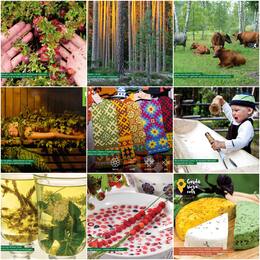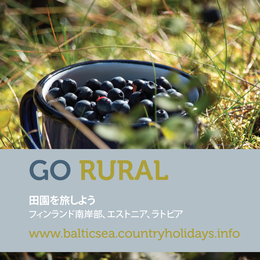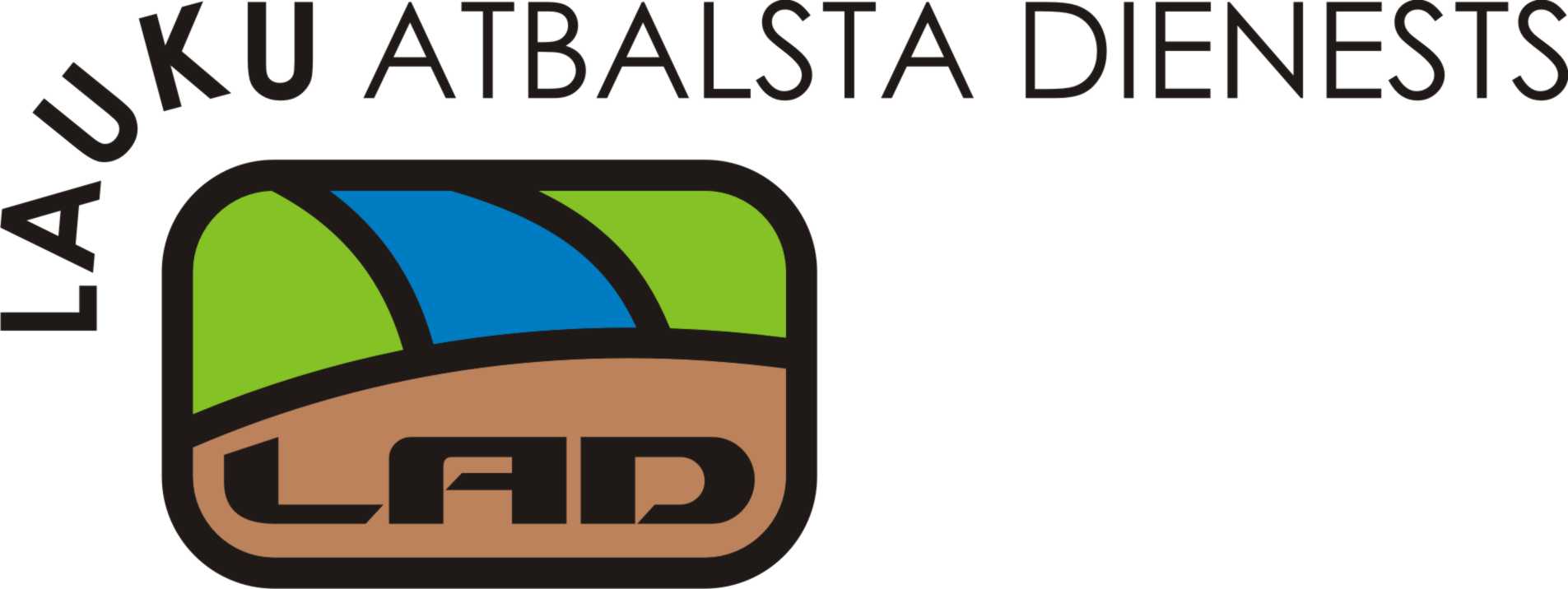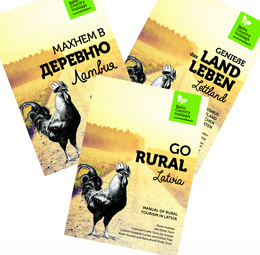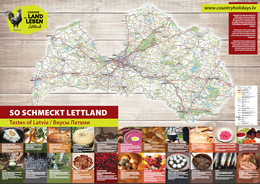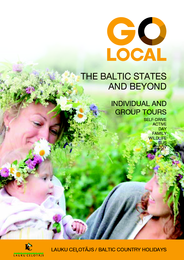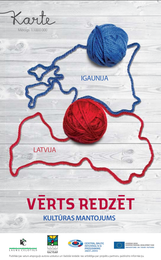Publications
Publications of "Lauku ceļotājs"
Our publications in English: accommodation catalogue „Country Holidays”, maps and travel guides for touring Latvia by car, bike, boating or hiking offer practical information and are most useful to plan and experience your holidays in Latvia. We have inspected all sites and tested all routes which are described. See below the details about contents of each of our publications.
To order the publications please send a request to the e-mail: lauku@celotajs.lv. You can pay for the publication with credit card or bank transfer. To read regular news about our new publications, please follow this link.
| Publication | Description |
|---|---|
Postcard greetings from rural LatviaWe have released a new collection of postcards with great images from rural life. The postcards tell about real rural feeling and heritage traditions that have lived through times and make part of today's life. So it's about what people still do in the countryside - go mushrooming in autumn, bake our special pīrāgi for festive table, and gather wild herb teas in the summertime. You can experience it visiting our countryside! If you want to say hello from Latvian countryside to your friends, send them a postcard! The postcards are available from the office of Baltic Country Holidays, 40, Kalnciema str., Riga. The postcard collection is produced under the project Heritage based agritourism product development in Latvia-Lithuania, supported by the EU Interreg Latvia-Lithuania programme 2014-2020.
|
|
The Baltic States and Southern FinlandThe people of the Baltic sea area have a close relationship with nature and its annual cycle. Each season has its own specific activities like mushrooming, berry picking, collecting herbs, ice-fishing and different agricultural jobs as well as traditional and seasonal celebrations. The countries are haven for the tourist who loves nature, respects traditions and would like to experience the countries and their cultures more deeply. Country-travelling tours and sites are based around small-scale accommodation, open farms, local producers, living traditions and sincere people. We' re always looking for local farms and producers and encourage the development of new products. We feel we can honestly call ourselves the Baltic rural exsperts in Estonia, Latvia and south Finland. Find us here: www.balticsea.countryholidays.info バルト三国とフィンランド南部 バルト海沿いの人々は自然や季節の移り変わりととても密接な関係を持っています。季節毎にキノコ狩り、ベリー摘み、ハーブ集め、穴釣り等それぞれのアクティビティがあり、多様な農作業を行ったり、伝統的な季節のお祝い事をしたりします。自然を愛し、伝統を敬い、もっと深く田園の文化を体験して知りたいと思う旅行者にとって、これらの国々は理想の地です。 田園を巡るツアーとその目的地は、小規模な宿泊施設、オープンファーム、地元の生産者、伝統的な生活、誠実な人々が基になっています。我々は常に協力してくれる地元の農園と生産者を探し、新しいプロダクトの開発を促しています。我々はエストニア、ラトビア、フィンランド南部の田園地帯に関するプロであると自負しています。 我々に関する詳細はこちらをご参照ください: www.balticsea.countryholidays.info |
|
Baltic Sea Culinary routesPeople alongside the shores of the Baltic Sea have kitchens with gifts from the forest, meadows, rivers, lakes and the sea. During the brief Nordic summer, there are carefully grown goodies from small gardens and farms. People think about future generations and use environmentally friendly farming methods so that the ingredients are fresh, clean, healthy and nutritious. Throughout the year, Baltic cuisine features rye bread, grains, fresh and fermented dairy products, and various cheeses. During the spring and summer, there are lighter dishes of fresh vegetables, herbs, berries, mushrooms and fish. During the winter and fall, the cuisine becomes substantial with meat, vegetables, legumes, pickled, marinated and spicy dishes that are supplemented with warming and aromatic spices. It is a matter of honour to prepare food from high-quality ingredients that are bought from trustworthy local manufacturers and suppliers. For that reason, it is best to taste oysters and shrimp in Denmark, salmon in Norway, liquorice in Finland, kama flour in Estonia, baked lampreys in Latvia, zeppelins in Lithuania, asparagus in Germany and rose petal jam in Poland. Bon appétit! |
|
Hiking Map Latviathe map also includes a description of 10 hiking routes that are marked with the 25 and described on the other side of the map. the map offers general information about the hiking routes that are contained therein. Before setting out, please look for additional information about the condition of objects, transport, accommodations, etc whether or not the objects are closed for reconstruction, etc. most of the routes lead along the seashore and small forest paths, along river valleys, etc. the map also includes 63 short nature trails , the symbol 38 hiking locations (parks, landscape areas, etc.) , and 142 viewing locations , including 72 landscape and bird watching towers . these objects of interest are in more than 50 protected environmental territories and many are cultural monuments . Some routes can be travelled on skis during the winter. other routes or parts thereof can be travelled by bike or by nordic walking. |
|
Latvian Heritage - 54 Latvian farmsThe „Latvian Heritage” sign of culture is meant for tourism businesspeople in Latvia who preserve and popularise Latvian cultural heritage by presenting it to visitors. The sign was established at the initiative of „Lauku ceļotājs” so as to honour and create Latvia’s cultural and household heritage as it exists today. The sign will indicate locations where owners are prepared to provide information to visitors, show things, serve Latvian dishes, teach crafts and skills, and celebrate Latvian festivals. The sign of Latvian heritage will be given to accommodations, farms, craftspeople, countryside saloons, organisers and directors of events related to Latvian traditions, museums, collections, and specialists in various skills and crafts. The sign has been presented since 2013 in partnership with the Latvian Ministry of Culture and the Latvian Association of Local Government. |
|
Wellbeing Tourism in LatviaThese leisure offers are intended to provide you with feelings of emotional, physical and spiritual wellbeing. Peace, quiet, open spaces, fresh air, pampering yourself, a healthy lifestyle, gentle exercise, beautiful surroundings, closeness to nature - all of these are skilfully merged to provide you with a sense of harmony, balance in your inner world, and to revitalise your energy. In Latvia, people has known for centuries how to use nature materials for their health and wellbeing. The knowledge about preparation of herbal teas, sauna switches, body masks and scrubs are inherited from generation to generation. |
|
Cycling Map of LATVIA, LITHUANIA, ESTONIA9 cycling routes, 240 tourism objects, how to travel to and around the Baltic States. This cycling map contains brief descriptions of 9 cycling routes withing the three Baltic States as well as descriptions of 240 tourism objects found along the |
|
Marketing project results"Marketing Campaign for Promotion of Rural Tourism and Development of Rural Tourism Products in all the Regions of Latvia" Project goalImplement rural tourism marketing campaign by creating and promoting rural tourism products that are based on rural resources and traditional values: local and regional food, culture and rural trade, producers of rural products. Project keynote – collaboration in all levelsContent of the Project mainly developed through discus- sions and collaboration with farmers, agricultural orga- nizations and local tourism information centres. Personal approach, discussions, seminars and surveys reflected the actual situation in the countryside and the needs of the farmers and the rural tourism. We organized meetings with entrepreneurs inspecting both opened to the visitors farms of „Countryside goodies” and public catering places that offer Latvian food. Rural tourism products that are developed during the Project are based on possibilities of the current offer taking into account references of the tourists and market tendencies. Due to participation, co-operation and personal interest of the farmers we have successfully implemented in practice the concept of “Go Rural”, developed the rural tourism products, organized “Open Days in the Countryside”, and developed criteria of “Latvian Food” and culinary product „Latvian Cuisine”.
|
|
Latvian Foods and BeveragesLatvia has a wealth of culinary traditions, because the country is at the crossroads of Europe, and so influences from other nations have come from the East and the West over the course of centuries. Latvian cuisine is distinctly seasonal, because we have four seasons, and each of them offers specific products and tasty treats. During the springtime, Latvians eagerly await the availability of birch juice. They grow green onions on windowsills. Onion skins are used to dye Easter eggs. Sorrel is sought out in gardens or meadows. Tarts with rhubarb are baked. The summer begins with wild and garden strawberries. Summer Solstice would not be Summer Solstice without caraway seed cheese and beer. Summer also involves new potatoes, cherries, tomatoes from the garden, ice cream, fresh honey, herbal teas and aromatic apples. Cranberry fool is whipped. Mushrooms are roasted and marinated. Mushroom hunting and fishing are nearly cult rituals or examples of meditation for Latvians. Meat is grilled over hot coals, and fish soup is cooked. Soured cream and dill can be added to nearly every dish. Pretzel-shaped pastry is baked for birthdays, and tarts are baked for weddings. People can pickles and jams, and they dry and freeze various goodies from the garden and the forest, because a long, hard winter is coming. During the autumn, Martin Day’s rooster or goose is roasted in the oven, with apple cake or poppy seed pastry for desert. Work sessions are held during the autumn, and potato pancakes are served. Fish, pork, sausages and even cheese can be smoked. Fresh butter is smeared on a slice of rye bread. Cranberries are used to produce lemonade. People buy and sell summer produce at annual markets. The Christmas table will groan under bacon pierogi, gingerbread, roast meats and sauerkraut. The Christmas table on New Year’s Eve, people roast fish and put fish scales in their pocketbooks so as to ensure money in the new year. All of the peas on the table are eaten so as to ensure no tears in the coming year. People believe that at least nine dishes must be served on New Year’s Eve to ensure that the next year will be a good one. Latvians are hospitable, and they will bring gifts when they come visiting and always give you one for the road when you’re leaving. |
|
Culinary map of LatviaThis map features 178 taverns, cafés, restaurants, rural tourist accommodations and other dining venues throughout Latvia (apart from Rīga). All of them prepare and honour Latvian dishes and traditions. Each listing includes a brief description of the venue and its name, its opening hours, contact information, geographic co-ordinates, and the location on the map. Latvian dishes and any special dishes prepared at the venue are also listed. Please note that some of the venues are not open at all times, instead working on the basis of reservations (such venues are marked with the "reservations required" symbol ). If you are part of a group of more than six people, please make reservations in advance in all cases so that the venue can prepare for your visit. The map of Latvia (1:550,000) shows all of the dining venues that are described here (the symbol 1 ). The map also presents ten culinary routes in Latvia. They are briefly described on the right side of the map. Full information about the routes can be found at www.tours.countryholidays.lv |
|
Go Rural LatviaGo Rural is a manual of rural tourism in Latvia for tourists as well as travel professionals. In this brochure we try to show Latvia through its best products and people who produce and grow them. We bring out rural feeling and places where you could go and relax as if visiting your grandma in the countryside. Fruits and vegetables in the gardens are available for your own picking. Several tours are ideal for families with children. During these tours children can see and learn from where the food is coming, feed and pat some farm animals and enjoy nature. In our tours we bring out the typical Latvian taste providing various tasting opportunities at the farms, country houses, local pubs and restaurants. We have several food and drink tours for groups. There are also crafts tours which allows to learn some useful skills. Using our many years' experience we also organize professional agrotours and provide consultation about rural tourism. |
|
Latvian Heritage - 40 Latvian farmsThe „Latvian Heritage” sign of culture is meant for tourism businesspeople in Latvia who preserve and popularise Latvian cultural heritage by presenting it to visitors. The sign was established at the initiative of „Lauku ceļotājs” so as to honour and create Latvia’s cultural and household heritage as it exists today. The sign will indicate locations where owners are prepared to provide information to visitors, show things, serve Latvian dishes, teach crafts and skills, and celebrate Latvian festivals. The sign of Latvian heritage will be given to accommodations, farms, craftspeople, countryside saloons, organisers and directors of events related to Latvian traditions, museums, collections, and specialists in various skills and crafts. The sign has been presented since 2013 in partnership with the Latvian Ministry of Culture and the Latvian Association of Local Government. |
|
Tastes of LatviaThis map shows the tastes of Latvia and encourages you to try typical food and drink during your travel. Traditional taverns, farmers' markets and open farms can be found on our website www.countryholidays.lv in the "Worth seeing" section. We can also organize special tours to farms, tastings and even participation in the food making process. The map of the Baltic States gives practical information about transportation which will be useful for planning your trip. |
|
Go Local - The Baltic States and BeyondIndividual and group toursself-drive, active, day, family, wildlife, bus, studyThe people of the Baltic have a close relationship with nature and its annual cycle. Each season has its own specific activities like mushrooming, berry picking, collecting herbs, ice-fishing and different agricultural jobs as well as traditional and seasonal celebrations. The country is a haven for the tourist who loves nature, respects traditions and would like to experience the countries and their cultures more deeply. Baltic Country Holiday's well-researched tours and sites are based around small-scale accommodation, open farms, local producers, living traditions and sincere people. For many years we have carried regular inspections of our accommodation and sites, have closely cooperated with national parks and nature experts, researched and developed new routes. We' re always looking for local farms and producers and encourage the development of new products. Since we ourselves like to explore and be active, we have tried all the routes in various different ways: cycling, walking, canoeing, by car and by public transport. We feel we can honestly call ourselves the Baltic experts. Upon receipt of your request we can tailor-make your itinerary through the Baltics according to your individual wishes and interests. We provide detailed road maps and road descriptions for all our tours. More on Baltic Country Holidays website: www.countryholidays.lv |
|
Cultural Heritage map "Worth Seeing" Latvia, EstoniaThe rural tourism associations in Latvia (Lauku Ceļotājs) and Estonia (Eesti Maaturism) have prepared a map related to cultural heritage which indicates 150 outstanding places where objects and traditions characteristic for various regions are maintained and offered to travellers as sources of interest. The understanding of cultural heritage is very broad, and this map invites users to visit craftspeople and their workshops, those who prepare local and traditional foods and beverages, small producers of farm products, fishermen, places where annual celebrations such as solstices are celebrated, biological and health- related farms, little saloons, museums and their collections, industrial monuments, the historical centres of cities, ethnographic villages and territories, thematic events related to history, reconstructions of historical events, sacral locations and buildings, certain castles and manor estates, places where national souvenirs can be purchased, trails and routes, and other destinations where there are special products for travellers. Here you will find a map of Latvia and Estonia with places where cultural heritage can be found, complete with descriptions of destinations and contact information for accommodations. |
|
